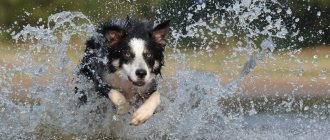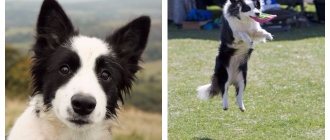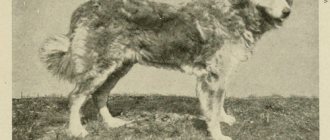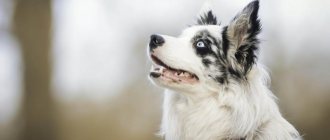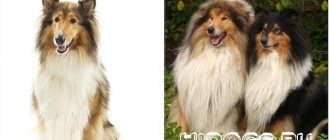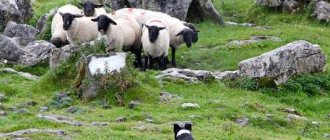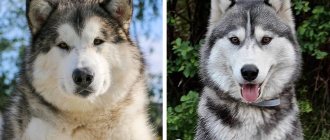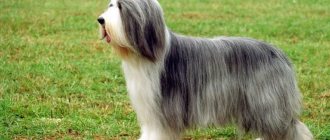The Scottish Sheepdog is a long-haired herding breed native to the grasslands of Scotland. The second name of the breed is collie.
This breed gained popularity after the release of the series “Lassie”, the main character of which was a Scottish collie dog. Millions of people immediately fell in love with the collie. Every person wanted to have their own “Lassie” in their apartment. The distinctive qualities of “Lassie” are beauty and elegance, as well as a gentle and kind disposition.
Collie is a collective name for a group of breeds, because each continent has its own “collie” with a separate history of development, although the roots are common. The Fédération Cynologique Internationale classifies collies as shepherd dogs.
History of the origin of the breed
Today there are two conflicting theories about the origin of the collie. The first of them says that in ancient times the ancestors of the Scottish Sheepdog came to Europe with the Romans, and the second suggests that Northern Europe already had its own shepherd dogs. Probably, both theories are partly true: migrating peoples took part in the formation of the collie breed, the Romans were part of the great migration of peoples.
The main difference between collies and other shepherd dogs is the lack of aggression. Theoretically, this is explained by the fact that wolves - the main opponents of shepherds and sheep - became extinct at the time the breed was formed. The main task of the Scottish Sheepdog remained to ensure that the sheep stayed together.
It’s funny, but the descendants of the ancient shepherds continue to herd people together today. Dogs don’t like it when people in their care scatter and collies try to gather the “flock” together by barking, as their ancestors did with sheep.
The collie breed gained popularity when Victoria's gaze turned to shepherdesses. The Queen liked these animals so much that she wanted to take them with her to Windsor. This moment marked the beginning of the collie's career as a companion dog. In the same year, collies participated in the exhibition for the first time, and two decades later a breed standard appeared.
The first individuals of this breed had black or black and white coat color; the dogs acquired their current appearance through targeted selection. Today a wide range of colors is known: black, black and white, harlequin, red and sable.
In the 20th century, collies were brought to the United States, the USSR and Australia.
The USSR adopted collies as service dogs, as orderlies, couriers and sappers.
History of the breed
Despite many theories, almost nothing can be said for sure about the history of the breed before the early 18th century. They appeared at a time when not only don’t I write anything about dogs, don’t write anything in principle.
Even the origin of the name is controversial. The most common belief is that the word collie comes from the Anglo-Saxon “col”, or black. The fact is that the traditional breeds of sheep in Scotland have a black mask on their face, and are called coleys, coallies, and coalleys.
As herding dogs that guarded these sheep, they were first called “Coallie dogs”, and then the phrase was shortened.
There is another theory that explains that the name comes from cailean or coilean, and means "dog".
These dogs have lived in England for centuries, if not millennia. They were especially common in Scotland, Northern England, and Wales, where they were guarded and herded sheep.
Like the name of the breed, its origin is vague, it is only clear that it is ancient. They are thought to be descended from the herding dogs of the ancient Romans, who invaded Britain in 43 BC. e., the Romans were experienced dog lovers, bringing more than one breed, including herding dogs.
This theory is supported by the fact that Scottish Sheepdogs are like their comrades in Europe, for example, the Beauceron.
Other experts believe that this breed is much older and was the herding dog of the Celts. They claim that dogs came with the Celts thousands of years ago, suggesting a date of origin for the breed of several hundred to several thousand years before Christ.
This explains why this type of dog is so common in regions with Celtic heritage and less common among English regions.
However, he does not take into account that Britain imported many other breeds, and these undoubtedly influenced the purebred collie.
Regardless of where and when these dogs appeared, they had one mission - to herd sheep. For hundreds of years, they helped their owners gather sheep into a herd and lead them to their grazing, picking up strays along the way.
They are valued for their working qualities, and their intelligence and dressiest are not inferior in price. But the peasants were very little interested in the appearance. It wasn't until the mid-18th century.
Before this, the collie was the same breed, I just meant the type of dog. There are dozens of different looking dogs, mostly Aboriginal. Although they were similar in body shape, size and temperament, the color, shape of the ears and muzzle were significantly different.
They were especially common in Wales, Scotland and Northern England. The collie that lived in Scotland we know today as the Scottish Sheepdog. Since at least the 16th century they have existed in longhaired and shorthaired variations.
Description of the breed with photos
The following parameters characterizing the collie can be distinguished:
- Strong type of constitution;
- The head is long and narrow, triangular;
- The ears are triangular, set high, the upper third drooping;
- A scissor bite is when the upper teeth are in front of the lower teeth;
- The tail is saber-shaped, reminiscent of a fox;
- Almond-shaped eyes are brown or black;
- Harmonious physique;
- Paws – thin, parallel, straight – calm, sweeping gait;
- Back – straight;
Breed variety
Among the Scottish dogs, there are two types: short-haired and long-haired collies. The length of the coat determines where exactly this type is distributed, since the peculiarity of the coat is directly proportional to the animal’s ability to resist cold.
Longhaired Scots are examples of the pride and aristocracy of the breed. Larger and more massive than the short-haired sisters, the main difference from the short-haired ones is the coat. Long hair and a thick, dense undercoat that retains heat during long walks.
Smooth collies are “light” and graceful shepherd dogs. Short-haired collies are lighter than long-haired collies and are smaller in size. Smart and curious. Distrustful, but not aggressive.
Size and weight
There are two types of collies - “classic” and “American”. Classic dogs are from 56 to 60 centimeters tall for males, and from 50 to 56 centimeters for females, at the withers. Weight averages 25 kilograms.
“American” collies – dogs bred in American breeding clubs – have sizes that differ from the “classic” ones to a larger extent. In addition, colors that are rejected in Europe are accepted in the United States. Even white collies with multi-colored spots on their bodies, somewhat reminiscent of Dalmatians.
Color and coat type
The breed standard implies three possible colors: tricolor, or also called tricolor, which includes three colors that are in harmony; red (light - sable) and marble. Regardless of the type of color, the collie is characterized by a white “collar”, “socks” and the tip of the tail.
A popular dog named Rob Roy is the pet of the President of the United States. Rob's special feature is albinism. Rob Roy's coat is white and his iris is red. Albinos are rare in nature; more often than not they do not survive because they have “weak” genes.
The breed is assessed on a ten-point scale based on the following characteristics:
- Health – 8.
- Training – 10.
- Character – 10.
- Attitude towards other animals and children – 10.
- Security qualities – 8.
- Ease of care – 3.
Description of the breed
Due to Lassie's incredible fame, few in the older generation do not recognize the long-haired collie. Because of this, they are more famous than shorthaired ones.
These variations differ in appearance, but are actually identical in everything except the length of the coat. Modern Scottish Sheepdogs are somewhat larger than their ancestors. Males reach 56-61 cm at the withers, and females 51-56 cm.
They weigh from 18 to 30 kg. Although most of the body is hidden under a thick coat, these are graceful dogs, well proportioned, with no part of the body being conspicuous in size.
The tail is long, the tip is slightly curved upward. When relaxed, the dog holds it low, but raises it when excited.
The shape of the head and muzzle is an important characteristic, as it distinguishes the Scottish Collie from other similar breeds.
It is proportional to the body and quite narrow, in the form of a blunt wedge with a very smooth stop.
The eyes are almond-shaped, medium, sometimes small, set obliquely.
Most dogs are dark in color, but in the blue merle, blue or mixed eyes are acceptable.
The ears are small and narrow, very expressive. When the dog is relaxed, they are directed back and slightly to the side.
When she is attentive, the lower part of the ear rises, the tip tilts freely forward. General impression of the dog: kindness, intelligence and attentiveness.
Collies come in long-haired and short-haired varieties. They have a double coat and a short and dense undercoat.
In the much less common shorthair, the outer coat is short, stiff, dense and smooth. The popular longhair is straight and hard to the touch, very thick.
There is a luxurious mane on the neck, and plumes on the back of the paws and tail. Short and smooth hair only on the face, ears and front of the paws.
Both variations come in three colors: sable (shades of light gold to dark, or dark sable), tri-color (black with tan markings on the legs and head) and blue merle (silver-blue with black spots and streaks). .
Health and illness
Collies are immune to viral diseases from birth due to the breed's grassland roots. But this does not mean that the dog is completely immune to disease. By six months, the puppy should be vaccinated against diseases such as canine distemper, enteritis and hepatitis. The main thing is not to forget to come for revaccination. In addition, at the age of one year, collies must be vaccinated against rabies. This is important because the rabies virus is incurable and is a contagious disease common to humans and animals. Lack of timely vaccination against rabies can cost the life of a pet, and in the worst case, also the life of the owner and his loved ones.
Before vaccination, the puppy must be completely healthy - the temperature must be normal, there must be no diarrhea or vomiting, lethargy or drowsiness. Otherwise, vaccination must be postponed until the animal has fully recovered.
In addition, before vaccination, the dog is “wormed” - freed from parasites - internal and external.
Allergies are a real scourge for Scottish women. More often it appears on chicken, cereals and vegetables. In addition to food allergies, collies are susceptible to other skin diseases, such as staph infections, which often affect the dog's ears. A preventive measure is a timely examination of the dog’s skin and ears. From time to time, a dog may suffer from dermatitis if the microclimate in the apartment does not meet its requirements: collie skin is sensitive to air temperature and humidity.
The shape of the ears and the fur around the eyes suggest possible otitis and conjunctivitis, and the size of the body suggests hip and elbow dysplasia.
At the first symptoms of disease, you should go to a veterinary clinic - the sooner treatment begins, the easier it is to prevent complex complications. For example, otitis media is fraught with meningitis and brain abscess, the latter, like rabies, is lethal. Self-medication does not help. The worst thing is that it can cause harm.
There is always the possibility of a medical error, and the likelihood of an error in a person without education is even higher. Even if the attempt to relieve symptoms is with the best intentions.
Lifespan
The lifespan of a pet depends on factors, among which genetic factors do not always lead. The life of the animal is influenced by the content and quality of feeding, to which collies are sensitive. Environmental conditions also contribute, because not a single living soul will feel comfortable in too cold or hot conditions. The average life expectancy of a collie is 13 years.
Character and intelligence
Collie is a reliable friend. However, with age, males begin to try to dominate, so from early childhood it is necessary to accustom the dog to the fact that in tandem the leader is a person. The dog's family is a pack, so during walks the collie will try to gather all family members into a group, just as it happened in the pastures with sheep. If he fails to achieve results right away, he will run and bark until people obey.
Depending on the type of collie, short-haired collies are more lively and playful than their calm, long-haired cousins. Scottish Shepherds are not afraid of water, love open water and happily swim in rivers and lakes. High intelligence allows dogs to successfully remember commands and even perform in circus performances, and their instincts make dogs excellent detectives who, like St. Bernards, look for people under rubble.
Attitude towards children and others
Collies welcome other animals with joy and love, almost immediately accepting them into their pack. During walks, she will not chase cats and other dogs, but will be happy to have company. Shepherds love children and will protect them; during walks they will never let the child out from under the watchful gaze and will not let the child go far from the parents.
Training and education
Smart and quick-witted dogs are easy to train and enjoy learning new commands. Even a beginner can teach a collie the simple commands “no”, “place” and “come”. Remembers the nickname and responds at the first call. However, the collie's character is very emotional and the best reward for the dog will be the owner's violent reaction to the executed command.
Dogs are tone sensitive and you should not yell or punish your collie. It is easier and more effective to switch the dog’s attention to another type of activity and return to training again - shepherdesses are very playful and this type of training is suitable.
You should not use hard metal collars for training. Such collars damage the coat and spoil the “collar” and appearance of the dog.
Character
These loyal and loving dogs are incredibly people-oriented. They prefer to spend most of their time with their family, and suffer incredibly without communication.
They are not well suited to being kept on a chain or even in a yard, even those who are away from home for a long time should think carefully before getting one.
Because of his attachment to his family, collies are wary of strangers. Although they are unfriendly, they rarely show aggression towards humans, and with proper socialization they can be quite friendly. If they shy away from strangers, it is not out of aggression, but out of timidity.
Sensitive and strokie, they make good bells declaring strangers. But as a guard dog they are weak, the dogs will greet strangers and some will run away in fear. This is a family dog, if properly socialized, great with children. They are affectionate and playful with them, but may (like all herding dogs) nip children in order to control them. He tells them instinct because that's how they control dumb sheep.
But this is a rare case, but if it happens, it is easily eliminated with training. They do not live in families where there are often scandals or fights; they are so sensitive that they are sick if they constantly get into family squabbles.
Collies get along well with other animals, including dogs. They work in tandem, and a low level of aggression towards other dogs is the norm for this breed. In addition, most are happy with other dogs, especially their own breed.
The life of a century shepherd will teach them to get along with other animals. Although they need socialization, they learn quickly and are not prone to offending neighbors. However, they have an instinct to control other creatures, which can seriously annoy cats.
Scottish Shepherds are incredibly smart and train. Although modern collies have lost some of their working abilities, the breed is intelligent and quick-witted. In addition, they are highly motivated to please people. If we exclude the elements and guard dog, what breed has no abilities, no tasks are impossible for it.
Harsh teaching methods and aggression are not only unnecessary, but also counterproductive. Sensitive, they don't know how to react because they are so eager to please. Praise works several times better, and will treat collies.
Pros and cons of the breed
Each dog from birth has its own natural disadvantages, which differ from breed to breed. Some behavioral deficiencies can be corrected by appropriate education and training. The owner literally “sculpts” the animal into the character that is needed.
Health-related disadvantages are avoided by timely prevention and vaccination.
Pros:
- Intelligence;
- Curiosity;
- Optimism;
- Loving nature;
- Beauty and stateliness;
- Patience and calm;
- Cleanliness;
- Devotion;
- Adaptability to family life;
Minuses:
- Mobility – requires plenty of walking;
- “Talkativeness” – frequent and loud barking;
- Timidity;
- Touchiness;
- Heavy shedding.
Both a plus and a minus is the sociability of the breed. If you don't leave your dog alone, nothing will happen.
The disadvantages can be leveled out with the right approach to raising and maintaining a dog, and you can also focus on the advantages. The whole picture depends only on perception.
Care
The hallmark of the Scottish Shepherd is its thick and luxurious coat. When looking at a collie, many people are horrified to think about grooming. These fears are completely justified. However, the situation is not so sad. Dealing with this is not easy, but it is possible. Particular attention is paid to wool before exhibitions, but even on weekdays, wool requires careful care. What is grooming?
It is worth noting that this dog is clean by nature and has a slight odor typical of dogs. The long-haired fluffy collie needs brushing. It is necessary to comb twice a week. Short-haired dogs only need to be brushed once. The combing process has its own subtleties. During the combing process, long hair is lifted and combed directly from the roots. Particular attention should be paid to the following areas:
- Breasts.
- Tail.
- Ears.
It is in these places that tangles most often form. The combing process takes on average 15 to 20 minutes. In real life, it's not that much. Water treatments are carried out as needed. As a rule, bathing occurs every month plus 2-3 weeks.
The eyes and ears play an important role in care. Since the Collie Sheepdog is susceptible to eye diseases, eye discharge must be removed regularly. It is best to use cotton swabs for this.
They must first be moistened in a special solution for the eyes. It is recommended to trim the animal's claws once a month.
Ears also need careful care. To avoid infection, fur must be removed regularly. In addition, your pet's ears need cleaning. For these actions, it is recommended to use cotton swabs.
Don't forget about your teeth. It is recommended to brush your teeth twice a week. To avoid unpleasant odor, you can brush your teeth every day.
As you can see, caring for and maintaining a collie requires responsibility. The care is thorough and practically no different from caring for a child. Naturally, this is a big responsibility. Both the health and mood of the animal depend on care.
Maintenance, care and nutrition
Scots feel great in an apartment. The main thing is to allocate a place to rest, a place in which the dog will feel safe.
The first thing that catches your eye is the collie's long and beautiful coat. Of course, it requires careful care.
Each combing session should take at least fifteen minutes; combing should be done every day, paying attention to the “mane” and tail, since these parts of the skin are susceptible to the formation of tangles. For combing, you need to use combs or combs with fine teeth, or use a standard brush.
Bathing - once every two months, or at times when the dog is too dirty - this is possible in autumn and spring. For bathing, use zoo shampoo or human shampoo for dry and brittle hair.
The ears are cleaned once a week, and they are inspected for injury or pus.
Teeth also need to be brushed regularly, otherwise your pet will be bothered by tartar.
The faster the nails grow, the more often they are trimmed. Some collies themselves wear off their claws on the road.
Discharge from the eyes should be carefully wiped off with tissues. If eye discharge appears too frequently or resembles pus, you should take your dog to the veterinarian: there is a risk of conjunctivitis.
Maintenance and care
The collie will feel great both in an apartment and in a private house, the main thing for her is attention, company and constant walks. They love children very much, treat them with special care and are always happy to play. They are friendly to other animals in the house. Despite the fact that collies have long and thick hair, caring for them is not labor-intensive. It is advisable to comb the dog with a special comb once a week. During the molting period, remove the undercoat with a slicker brush. Particular attention should be paid to the hair behind the ears, on the neck, dewlap and hips.
Collies feel great in an apartment, but will also be happy in a private house with a large yard. The main thing is that the family is always nearby and pays a lot of attention to the dog. Grooming is minimal. It needs to be brushed once a week. They bathe as needed, more often during the molting period, at which time the dog needs to be combed vigorously, 3-4 times a week. When ears become dirty, wipe them with a damp cotton swab. Sometimes the claws have to be trimmed.
Natural feeding
Complex and time-consuming process. It is necessary to create a balanced diet that is suitable specifically for this dog - it is easier to seek help from a veterinary nutritionist.
It is necessary to feed the dog at the same time, this is due to the physiology of digestion. Puppies eat up to five times a day, and adult collies three times.
An adult collie can:
- Beef (boiled);
- Liver (beef);
- Eggs;
- Boneless fish fillet;
- Cottage cheese and cheese;
- Porridge, vegetables;
It is worth noting that every dog, including collies, is a predator, which means that historically the animal’s digestive system is adapted to eating meat. Therefore, meat should be the predominant part in a dog’s diet.
Products contraindicated for collies:
- River fish;
- Bones;
- Pork and lard are too fatty;
- Pea and pearl barley, as well as fresh peas;
- Sweet and floury.
What to feed your collie
You can feed your Scottish Shepherd with any of two schemes: natural food or wet and dry food. When choosing the second option, you should know that it will be difficult to switch the dog to another food in the future. If the food is natural, the diet should be well-balanced and complete.
Of course, every person strives to find the ideal diet solution from an economic and nutritional point of view. Knowledge of foods that should not be given to a Scottish Shepherd will help you with this. It is not recommended to give the animal the following products:
- raw river fish;
- raw pork and lard;
- fried potatoes;
- flour products;
- pearl barley;
- tubular bones;
- peas.
Exclude these products from your planned diet, and it will be easier for you to create a menu for your collie. And don't forget about vitamin and mineral supplements.
Dry food
Dry food is divided into economy class food and premium food.
The advantages of this food are that there is no need to spend time preparing food for the dog; in addition, the food is balanced in fats, proteins, carbohydrates, minerals and vitamins.
A collie that is sensitive to food and prone to allergies and poisoning will not tolerate cheap, low-quality food, so this option should be dismissed immediately and not even thought about. A veterinarian will help you choose the right food. You should pay attention to the color and composition of the feed - the quality of the feed is confirmed if the amount of meat prevails in the composition, and the by-products used are indicated without trying to hide: liver, kidneys, lungs. Otherwise, hooves and horns, the nutritional value of which is extremely low, end up in the food. In addition, if the content of grains and vegetables in the food is predominant, the collie may develop food allergies.
How to choose a puppy
First, you need to decide what the puppy is needed for. A sporting dog, a show star or a friend and beloved pet. The approach to choice and the price category of the baby depend on this.
If you plan to send the puppy to an exhibition in the future, then you need to tell the breeder about this and, together with him, make sure of the purity of the pedigree of the parents of the little collie. Show puppies must not have breed defects.
However, if a dog is purchased as a pet and devoted friend, then the main thing is health. You can check this parameter yourself. An eight-month-old Scottish Shepherd puppy should maintain a straight back and strong, even paws, a round muzzle, not narrow like in adult dogs, a long neck, ears hanging forward, and a square body. The coat and bite are also formed by this age.
You also need to pay attention to the living conditions of the cubs. If the conditions are insufficient, you should refuse to buy a puppy from this kennel. It is impossible to raise healthy animals in dirt, dust and cramped conditions.
In addition, even puppies of the same litter can differ from each other. Each litter produces both timid and brave puppies. Although the character of an adult dog is formed depending on upbringing, the predisposition to specific character traits is laid down genetically in the womb of the mother dog.
By the fiftieth day of a puppy’s life, intelligence has already formed: the right time to determine the dog’s ability to be trained, to dominate or submit in tandem with a person, to recognize the fears of the future pet, such as the fear of heights or loud sounds.
Similar breeds
The Sheltie is the first dog breed that comes to mind when compared to the Collie. The original name of the Sheltie was Tuni Dog. The Sheltie can be called a miniature copy of the Scottish Sheepdog; these two breeds are very similar to each other. The Sheltie was also used to help shepherds herd sheep in the pastures.
A harmonious dog, the lines of the body and muzzle are neat and smooth. Just looking at a dog creates a feeling of calm. The Sheltie's character is affectionate, kind, and friendly. A sheltie will make a cozy pet, no worse than a collie.
Video about the breed
https://youtu.be/LzLvC5Ye5rM
In conclusion, it is worth saying that collies are a wonderful choice for family people. Along with the companion, the owner will receive a vigilant nanny and a security guard.
With such a dog there will be no time to be bored, because the curious nature of the animal strives to learn something new.
The dog's majestic coat will please the eye, and there will be no problems with it if you take care of it responsibly. However, people who are too busy at work should avoid choosing this breed as a companion, since collies require attention, love and long walks.
